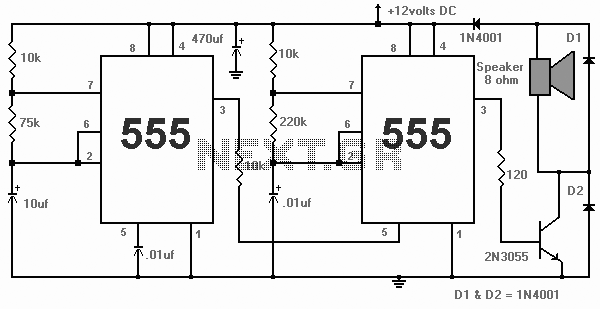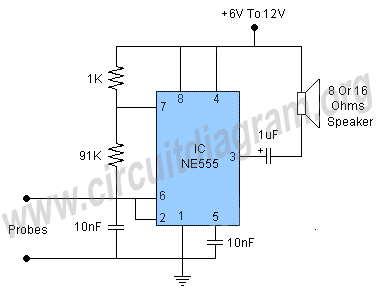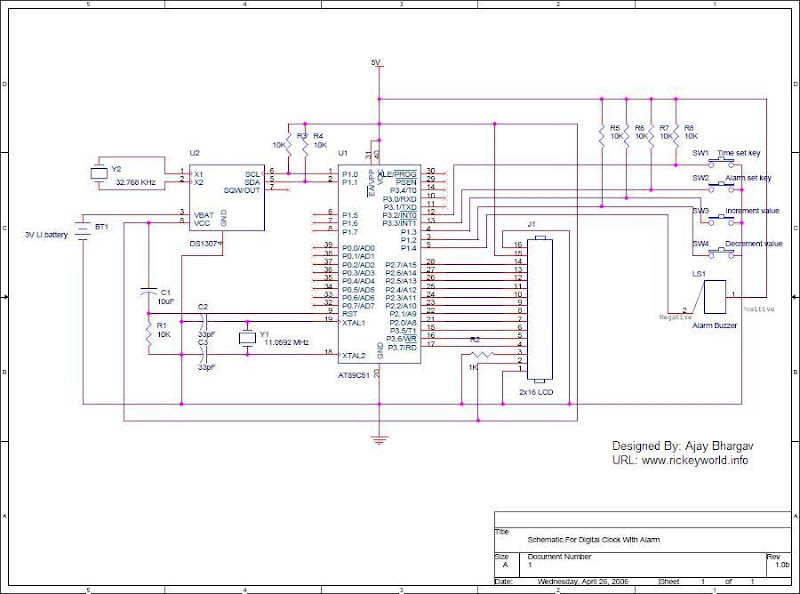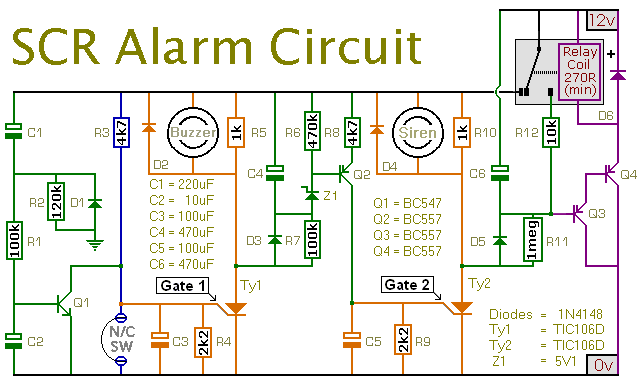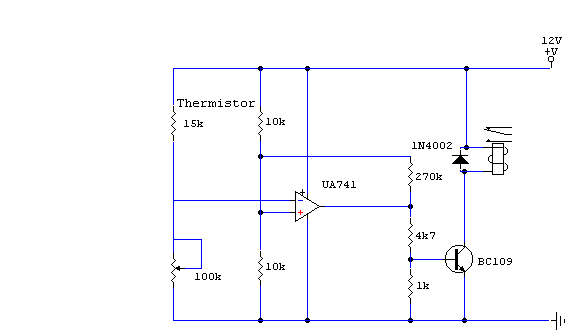
3V Sweeping Siren Alarm
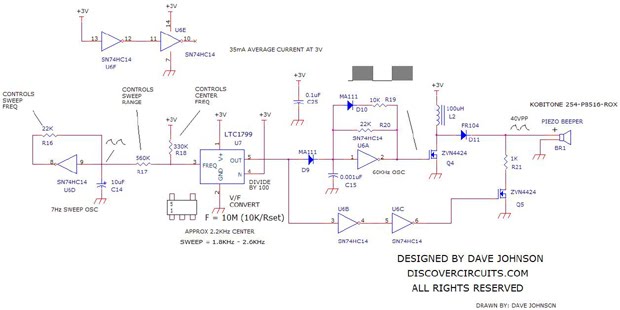
A loud sweeping siren-type audio sound generator powered by 3V. The circuit utilizes an LTC1799 precision frequency generator from Linear Technology and a 74HC14 hex Schmitt trigger from Texas Instruments to perform various functions. One section is configured as a simple 7Hz square wave oscillator. The triangle waveform across the capacitor generates the low-frequency sweeping signal for the siren. Two resistors bias the LTC1799 for a center frequency of approximately 2KHz. A flyback DC to DC converter circuit produces a 40V peak signal, which is activated and deactivated according to the output of the LTC1799. The output connects to a quality piezoelectric beeper with a resonant frequency of about 2.5KHz. The result is a loud siren that draws only 40mA from a 3V supply. A suitable piezoelectric device is the Kobitone part number 254-PB515-ROX (Mouser part number 245-PB516). For a smaller alternative, the Murata PKM17EPP-2002-BO (Digikey part number 490-4688) can be used, though it may not be as loud.
The described circuit is an effective audio sound generator designed to produce a loud and attention-grabbing siren-like sound. The LTC1799 frequency generator is crucial for establishing the base frequency of the audio output. When configured, it allows for precise control over the frequency and duty cycle of the output signal, which is essential for generating the desired sweeping effect.
The 74HC14 hex Schmitt trigger serves multiple purposes within the circuit, including signal conditioning and waveform shaping. Its role as a square wave oscillator at 7Hz provides the modulation necessary for creating the sweeping sound characteristic of sirens. The triangle waveform produced across the capacitor is integral to generating a low-frequency signal, which, when combined with the square wave, results in a rich audio experience.
Biasing the LTC1799 with two resistors enables the circuit to maintain a center frequency around 2KHz, ensuring that the output remains within the optimal range for auditory perception. The flyback DC to DC converter is a critical component that steps up the voltage to 40V, allowing the circuit to drive the piezoelectric beeper effectively. The beeper, with its resonant frequency near 2.5KHz, is selected for its ability to produce a loud sound while maintaining efficiency.
The overall design ensures that the circuit operates with low current draw, consuming only 40mA from a 3V supply, which enhances its suitability for battery-powered applications. The choice of piezoelectric devices, such as the Kobitone and Murata models, provides options for users depending on size and loudness requirements, allowing for flexibility in design choices based on specific project needs.A very loud sweeping siren type audio sound generator powered by 3v. The circuit uses a LTC1799 precision frequency generator from Linear Technology. A 74HC14 hex Schmitt trigger from Texas Instruments is also used to perform several other functions. One section is wired as a simple 7Hz square wave oscillator. The triangle waveform across that capacitor generates the low frequency sweeping signal for the siren. Two resistors bias the LTC1799 for a center frequency of about 2KHz. A flyback DC to DC converter circuit, produces a 40v peak signal, which is turned on and off according to the output of the LTC1799.
The output is connected to a quality piezoelectric beeper, which has a resonant frequency of about 2. 5KHz. The result is a siren which is quite loud but draws only 40ma from a 3v supply. A piezoelectric device from Kobitone, part number 254-PB515-ROX, (Mouser part number 245-PB516) shown above works well.
If you want something much smaller, although not quite as loud, try the Murata PKM17EPP-2002-BO shown above (Digikey part number 490-4688). 🔗 External reference
The described circuit is an effective audio sound generator designed to produce a loud and attention-grabbing siren-like sound. The LTC1799 frequency generator is crucial for establishing the base frequency of the audio output. When configured, it allows for precise control over the frequency and duty cycle of the output signal, which is essential for generating the desired sweeping effect.
The 74HC14 hex Schmitt trigger serves multiple purposes within the circuit, including signal conditioning and waveform shaping. Its role as a square wave oscillator at 7Hz provides the modulation necessary for creating the sweeping sound characteristic of sirens. The triangle waveform produced across the capacitor is integral to generating a low-frequency signal, which, when combined with the square wave, results in a rich audio experience.
Biasing the LTC1799 with two resistors enables the circuit to maintain a center frequency around 2KHz, ensuring that the output remains within the optimal range for auditory perception. The flyback DC to DC converter is a critical component that steps up the voltage to 40V, allowing the circuit to drive the piezoelectric beeper effectively. The beeper, with its resonant frequency near 2.5KHz, is selected for its ability to produce a loud sound while maintaining efficiency.
The overall design ensures that the circuit operates with low current draw, consuming only 40mA from a 3V supply, which enhances its suitability for battery-powered applications. The choice of piezoelectric devices, such as the Kobitone and Murata models, provides options for users depending on size and loudness requirements, allowing for flexibility in design choices based on specific project needs.A very loud sweeping siren type audio sound generator powered by 3v. The circuit uses a LTC1799 precision frequency generator from Linear Technology. A 74HC14 hex Schmitt trigger from Texas Instruments is also used to perform several other functions. One section is wired as a simple 7Hz square wave oscillator. The triangle waveform across that capacitor generates the low frequency sweeping signal for the siren. Two resistors bias the LTC1799 for a center frequency of about 2KHz. A flyback DC to DC converter circuit, produces a 40v peak signal, which is turned on and off according to the output of the LTC1799.
The output is connected to a quality piezoelectric beeper, which has a resonant frequency of about 2. 5KHz. The result is a siren which is quite loud but draws only 40ma from a 3v supply. A piezoelectric device from Kobitone, part number 254-PB515-ROX, (Mouser part number 245-PB516) shown above works well.
If you want something much smaller, although not quite as loud, try the Murata PKM17EPP-2002-BO shown above (Digikey part number 490-4688). 🔗 External reference
